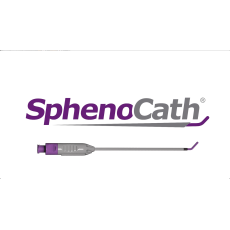Sphenocath intranasal catheter
What is a Sphenopalatine Ganglion Block?
A ganglion is a collection of nerve cells that helps to regulate certain functions within your body. The sphenopalatine ganglion (SPG) is located in the back of the nose and plays a role in many types of headaches including migraines, cluster, Trigeminal Neuralgia, atypical facial pain, and other facial pain syndromes. Migraine headache treatment by application of medication to the SPG has been done for over one hundred years. If the medication used is intended to temporarily block function of the SPG, this is called a SPG block or SPGB. If you healthcare provider decides that a SPGB is right for your condition, they should further clarify the procedure and answer any questions you may have before proceeding.
What is the SphenoCath®?
If your practitioner decides that a SPGB is right for you, they may decide to use the SphenoCath®. The patented SphenoCath® is a small, soft tube specifically designed to be gently inserted into a patient’s nose, as they lie on their back, and deliver medication precisely and consistently to the area of the SPG. The SphenoCath® is not a headache treatment per se. It is a medication delivery device that transforms a SPGB into a quick, simple, comfortable procedure. If your practitioner consults with you about a SPGB and you decide on the procedure, ask your provider to use the SphenoCath® to do the procedure.
What Should I Expect During the Procedure?
You will be placed on a procedure table on your back with a towel or pillow under your shoulders to allow your head to be tilted back. Sometimes providers pre‐medicate the nasal passages with a topical anesthetic spray or gel in the nose. This is not necessary, but may make the procedure more comfortable. Your provider will gently insert the SphenoCath® device into one of your nostrils. You may feel slight discomfort as the catheter approaches or touches the nasal bone. The SphenoCath® device is positioned so that the anesthetic will reach the sphenopalatine ganglia (SPG).
Most patients experience very little or no discomfort when the tube is inserted. Once in position, your provider will inject a small amount of anesthetic into the back of your nasal cavity. This procedure is immediately repeated on your other side. Some patients experience an unpleasant taste in their mouth or a temporary unpleasant numbness in their throat during or immediately after the procedure from the anesthetic. Some patients experience a temporary feeling of having difficulty swallowing, but this is just a feeling, patients can still swallow and the sensation resolves in a few minutes. Also, you may experience some lightheadedness or dizziness for a short time after the procedure. Most patients can resume their normal activities within 15‐20 minutes. You should drink plenty of water both before and after the procedure, maintain your normal caffeine consumption both before and after, and avoid strenuous physical exertion (including sexual activity) for at least 72 hours after the procedure. If your nasal passage has an irregularity that makes the procedure difficult, your provider may refer you to have the procedure done under x‐ray guidance.
How is a SPGB Accomplished?
When a SPGB was first performed, it was done using a long needle through the side of the face. Some practitioners still use this approach. More commonly, the procedure is performed by using a long, stiff, cotton-tipped applicator through the nose to apply medication near the appropriate area in the back of the nasal passage. This can be uncomfortable for patients, is often difficult or unsuccessful, and can cause bleeding. Some people simply drip medicine into the nose hoping that it arrives at the correct location. There are several other methods that are less often utilized and less effective. The SphenoCath® allows your provider to administer a SPGB quickly, comfortably, and effectively.
Manufacturer: Sphenocath, USA.



